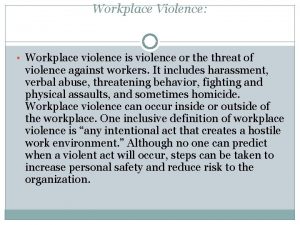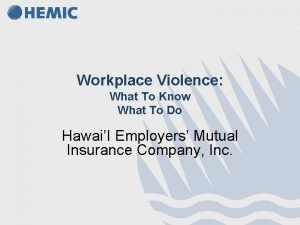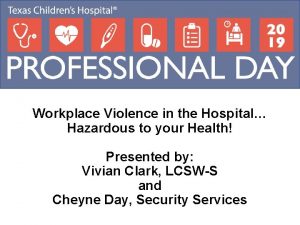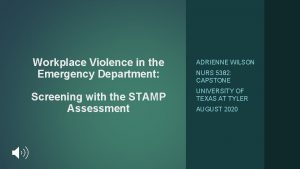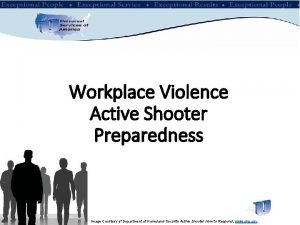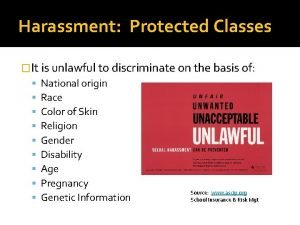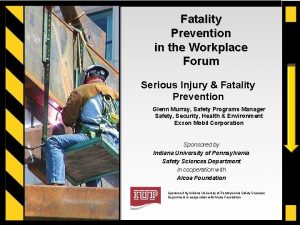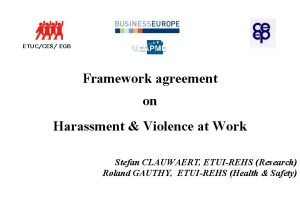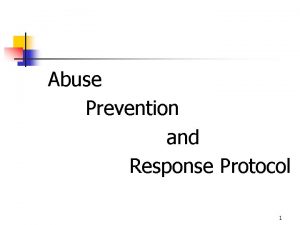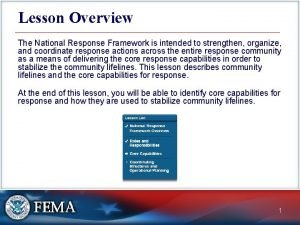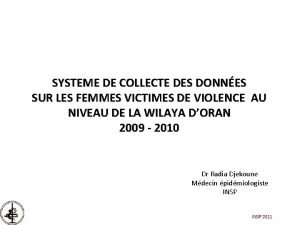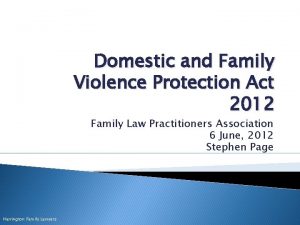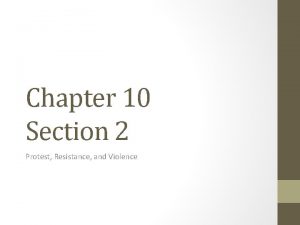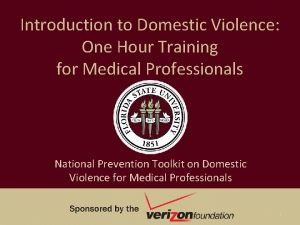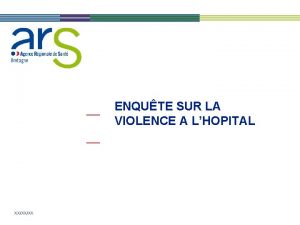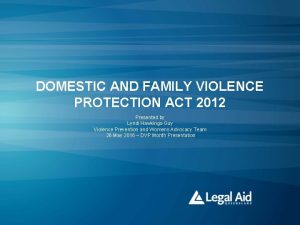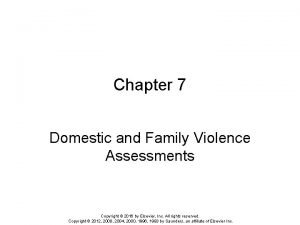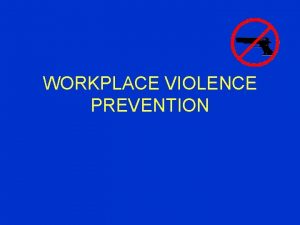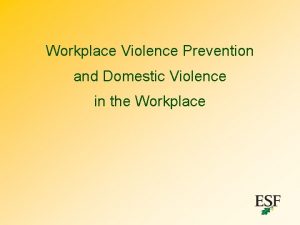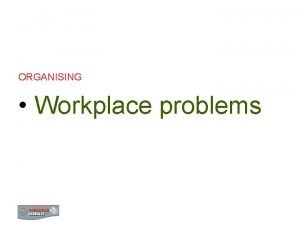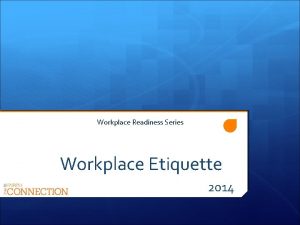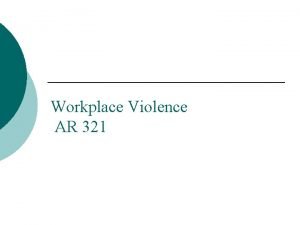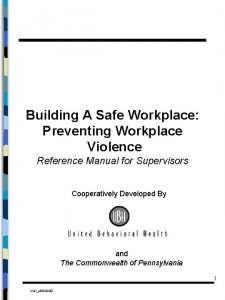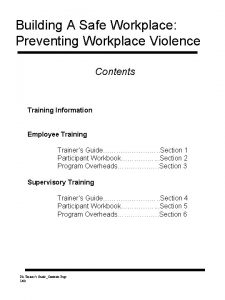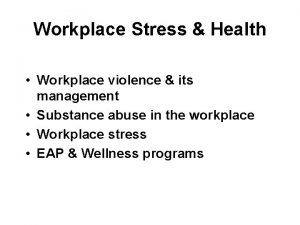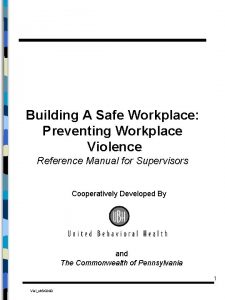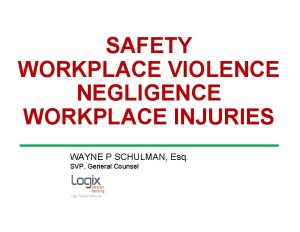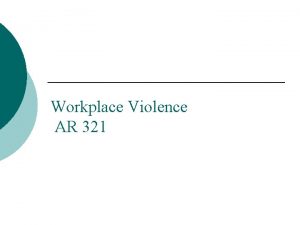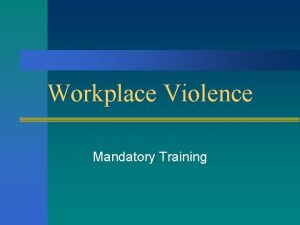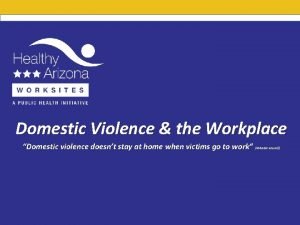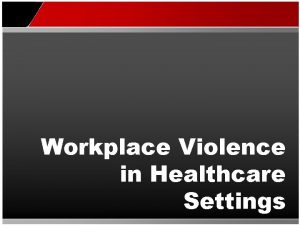A Framework for Workplace Violence Prevention Response 1














































































































- Slides: 110

A Framework for Workplace Violence Prevention & Response 1 v 1. 4 a Prepare | Prevent | Respond | Recover

You can find the latest here… 2

Welcome • Who are we? (the trainers) • Who are you? (name & unit) • What experience do you have with Workplace Violence? • What is this going to be all about? 3

Purpose To give you the information you need to help make your Local Workplace Violence Prevention & Response Team a success 4

“The great moral issue … is violence. We have lived and gathered wealth and power increasingly by violence. ” Wendell Berry 5

So … • What is violence? • Why should we care about violence in the workplace? • What can we do about violence in the workplace? 6

Background: Moral (1) All employees are responsible for … creating an environment of mutual respect for co-workers and clients. (DOL Workplace Violence Prevention Policy) 7

Background: Moral (2) All employees are responsible for fostering good public relations by: • Giving fair and courteous treatment to each person; • Respecting the dignity of every individual; and • Doing the job to the best of the employee’s ability. (GA Manual 0604) 8

Background: Practical • Verbal and physical violence in the workplace not only threaten the safety and well-being of our employees and customers, but also adversely affect job performance and customer satisfaction. • Verbal and physical violence are the outward expressions of mental and emotional violence which affect a person’s wellness. 9

Background: Legal (1) 2 On June 7, 2006, New York State enacted legislation creating a new Section 27 -b in Section 2 of the New York State Labor Law that requires public employers (other than schools covered under the school safety plan requirements of the education law) to perform a workplace evaluation or risk evaluation at each worksite, to develop and implement programs to prevent and minimize workplace violence caused by assaults and homicides, and to regularly evaluate the risks and the program’s effectiveness. The Law was effective March 4, 2007. 10

Background: Legal (2) 3 On April 29, 2009, the New York State Final Rule was published in the State Register. The Rule was effective on that date. [See Section (k)]. 11

Background: National On February 28, 2003, President Bush directed the Secretary of Homeland Security to develop and administer a National Incident Management System (NIMS). This system provides a consistent nationwide template to enable Federal, State, tribal, and local governments, nongovernmental organizations (NGOs), and the private sector to work together to prevent, protect against, respond to, recover from, and mitigate the effects of incidents, regardless of cause, size, location, or complexity. 12

Background: Administrative • The Department of Labor is committed to vigorously enforcing the law and enacting a model program to protect our own workers. • Preventing and Responding to Workplace Violence is consistent with our mission to Protect, Assist and Connect. 13

Definition: Workplace Any location away from an employee’s domicile, permanent or temporary, where an employee performs any work-related duty in the course of his or her employment. 14

Definition: Workplace Violence Any physical assault, threatening behavior, verbal abuse occurring where a public employee performs any work-related duty in the course of his or her employment. 15

Categories of Workplace Violence Type 1: Violent acts by criminals, who have no other connection with the workplace, but enter to commit a robbery or another crime. 16

Categories of Workplace Violence Type 2: Violence directed at employees by customers, clients, patients, students, inmates, or any others for whom an organization provides services. 17

Categories of Workplace Violence Type 3: Violence against coworkers, supervisors, or managers by a present or former employee. 18

Categories of Workplace Violence Type 4: Violence committed in the workplace by someone who doesn’t work there, but has a personal relationship with an employee, this can be an abusive spouse or a domestic partner. 19

Definition: Workplace Violence Incident (1) • An attempt or threat whether verbal or physical to inflict injury upon another employee; • Any intentional display of force which would give an employee reason to fear or expect bodily harm; • Intentional and wrongful physical contact with a person without his or her consent that entails some injury or offensive touching; 20

Definition: Workplace Violence Incident (2) • Harassment of a nature that would give an employee reason to fear escalation or make it difficult to pursue a normal life when the harassment arises out of or in the course of employment; • Stalking an employee with the intent of causing fear when such stalking has arisen through or in the course of employment. 21

Definition: Workplace Violence Prevention Program An employer program designed to prevent, minimize and respond to any physical assault, threatening behavior or verbal abuse occurring in the workplace. 22

Elements of an Effective Workplace Violence Prevention Program • Management commitment and employee involvement • Employee Representative participation • Risk Evaluation • Hazard control • Workplace Violence Prevention Policy • Employee training • Record keeping system • Program evaluation 23

Definition: Workplace Violence Prevention Team A group formed at each local Department office comprised of a member of management designated by the management head of the local office, and no less than one member from each of the authorized employee representatives’ organizations that have an interest in the local office, and such other members in the discretion of the office manager. 24

Responsibilities: Workplace Violence Prevention Team • This group is responsible for assisting in an assessment at that office of the risk of workplace violence, consulting on a draft of a program for that office, providing local information and training, and reviewing the effectiveness of the program. • These teams may receive assistance from the state-wide and regional safety and health committees. 25

Framework • • Prepare Prevent Respond Recover 26

Prepare (1) • Workplace Violence Prevention – Workplace Violence Prevention Teams – Statewide list of certified employee assistance professionals to assist affected employees in cases of serious workplace violence incidents. – Statewide Framework Briefing – Risk Assessment Team Training – Local Risk Assessment and Control – Local Information & Training 27

Prepare (2) • • Sexual Harassment Prevention Training Domestic Violence Prevention Training Nonviolent Response Training NIMS (National Incident Management System) • EAPs (Emergency Action Plans) 28

Prepare: Sexual Harassment Prevention Training Preview (1) Sexually Harassing Behavior includes: – Physical assault – Unwelcomed touching, leering or ogling – Unwanted comments or sexual humor – Sexual intimidation 29

Prepare: Sexual Harassment Prevention Training Preview (2) Strategies for Preventing and Eliminating Sexual Harassment include: – Know DOL’s sexual harassment policy (GA Manual 0250). – Become mindful of your behavior. – Model professional behavior. – Respect the rights of others to work in a harassment-free environment. 30

Prepare: Domestic Violence Prevention Training Preview (1) • • Domestic violence is a pattern of coercive tactics which can include physical, psychological, sexual, economic and emotional abuse, perpetrated by one person against an adult intimate partner with the goal of establishing and maintaining power and control over the victim. It is a learned behavior that is not justified by substance abuse, stress, etc. 31

Prepare: Domestic Violence Prevention Training Preview (2) Domestic Violence is a concern in the workplace because: – It affects many employees. (One in four women experience domestic violence; over 82, 000 women are employed by NYS. ) – It is a security and liability concern. (Employers can be liable for failure to properly administer a Domestic Violence Prevention Program. ) – It affects health care costs. (>$ 4. 1 billion a year. ) – It affects performance and productivity. (> $ 700 million in lost productivity and > 7. 9 million paid workdays lost each year. 32

Prepare: Domestic Violence Prevention Training Preview (3) Why don’t victims leave? Video - Domestic Violence: The Workplace Responds 33

Prepare: Domestic Violence Prevention Training Preview (4) • The DOL Policy is posted on the DOL Intranet under Your Safety & Health. • Posters have been placed at each DOL location. 34

Prepare: Nonviolent Response Training Preview (1) We will be offering CPI’s Prepare. Training® Program • Participants in the Prepare. Training® Foundation Course will be enabled to: – Recognize early warning signs of anger or hostility. – Effectively utilize personal space, body language, and paraverbal communication to relieve tension and defuse hostility. – Employ verbal intervention strategies to de-escalate situations before they become more disruptive or potentially dangerous. – Maintain an objective and professional attitude when responding to an agitated individual. – Invoke four priorities essential to the Department’s Violence Response Procedures. – Effectively debrief once tension reduction occurs. 35

Prepare: Nonviolent Response Training Preview (2) Some Terms • Respect, Service, and Safety at Work®: the goal of CPI’s Prepare. Training® Program – Respect: Treating others with courtesy, preserving dignity – Service: Meeting commitments, maintaining professionalism – Safety: Preventing danger, risk or injury • Integrated Experience: our attitudes and behaviors impact the attitudes and behaviors of others, and vice versa. • Precipitating Factors: internal or external causes of behavior over which we have little or no control. • Rational Detachment: the ability to control our own behaviors and not take hostility personally. • CPI Crisis Development Model. SM: a description of agitated and hostile behaviors and appropriate responses that can best help a person and prevent escalation. 36

Prepare: Nonviolent Response Training Preview (3) The CPI Crisis Development Model Behaviors 1. Anxious 2. Defensive 3. Physically Violent 4. Tension Reduction SM Appropriate Responses 1. Supportive 2. Directive 3. Local Violence Response Procedures 4. Debrief 37

Prepare: Nonviolent Response Training Preview (4) The CPI Crisis Development Model Anxious SM Supportive • • • Respect their space Be non-threatening Be open and interested Make gentle eye contact Speak softly, slowly and evenly Use empathic listening – Be non-judgmental – Give undivided attention – Focus on facts and feelings – Allow silence – Restate to clarify – Listen for underlying messages 38

Prepare: Nonviolent Response Training Preview (5) The CPI Crisis Development Model Defensive Directive • Questioning • • Refusal • • Release • • Intimidation • SM Answer informational questions; redirect confrontational questions back to the topic. Set simple, clear, reasonable and enforceable limits; explain choices and consequences; state the preferred choice first; allow time Let them vent; remove the audience; give non-threatening directives; be understanding and reasonable; and enforce any limits you set. Take seriously; seek assistance; wait for assistance; and avoid individual intervention. 39

Prepare: Nonviolent Response Training Preview (6) The CPI Crisis Development Model Acting Out SM Local Violence Response Procedures Be sure to: 1. Keep yourself safe. 2. Assess the situation. 3. Summon assistance. 4. Make the environment as safe as possible. 40

Prepare: Nonviolent Response Training Preview (7) The CPI Crisis Development Model Tension Reduction SM Debrief This may include: 1. Identifying what led up to the incident. 2. Exploring how recurrences can be prevented. 3. Assessing the effectiveness of the intervention efforts. 4. Exploring ways to improve future interventions. 5. Offer support to those involved. 41

Prepare: National Incident Management System - NIMS (1) • The National Incident Management System, or NIMS, provides the foundation needed to ensure that we can work together when our communities and the Nation need us the most. • NIMS integrates best practices into a comprehensive, standardized framework that is flexible enough to be applicable across the full spectrum of potential incidents, regardless of cause, size, location, or complexity. • Using NIMS allows us to work together to prepare for, prevent, respond to, recover from, and mitigate the effects of incidents. 42

Prepare: National Incident Management System - NIMS (2) • NIMS is a consistent, nationwide, systematic approach that includes the following components: – Preparedness – Communications and Information Management – Resource Management – Command Management (ICS) – Ongoing Management and Maintenance • NIMS online courses can be found at www. training. fema. gov/IS/NIMS. asp 43

Prepare: DOL Emergency Action Plans - EAPs • All Locations must have an updated yearly Emergency Action Plan reviewed by staff • Plans should: • Prepare staff for fire and other emergencies, communication protocol, incident handling, and evacuation • Focus on Prepare, Prevent, Respond and Recover • Beginning in 2008, EAPs must be integrated with NIMS and DOL Workplace Violence Prevention & Response requirements 44

Prevent • Risk Assessment 4 5 – Checklist 4 – Narrative • Hazard Control, Approval & Implementation (Risks & Fixes) • Local Information and Training 45

Prevent: Summary • Name and meet with WPVP Team • Perform Facility Risk Assessment • Submit the completed assessment form for approval with narrative and appropriate documents attached to: – – • • Location WPVP Team Workplace Violence Prevention emailbox (labor. sm. wpvp) [Office of Special Investigations] [Deputy Commissioner for Administration] Meet with employees to discuss approved program Post approved program Provide Local Information & Training to all employees Certify that all employees have received required training by emailing OSOD Services (labor. sm. osod. lms) 46

Prevent: Risk Assessment (1) • The Workplace Violence Prevention Teams will assess the employees’ work environment for potential or actual risk hazards. – A review of the GA 51 s (Unusual Incident Reports), 7 and SH 900. 2 s (Injury and Illness Incident Reports), and other relevant documents. 8 – A physical workplace evaluation addressing site security including building access, lighting, door locks, alarms, isolated spaces, etc. – Risk prevention information based on staff surveys and/or focus groups. – A review of our existing policies for violence prevention, crisis response and incident management, domestic violence and workplace rules of conduct. 47

Prevent: Risk Assessment (2) • • The Workplace Violence Security Checklist 5 must be used to evaluate the risks and dangers to: – Field Staff (Enforcement, Service and Investigations) – Office Staff (Open and Closed to the Public) – Customer Service Staff (In person and by telephone) – Support Staff – Any other DOL employees – Participating Partner Staff Risk Assessments must be performed Preand Post-Occupancy. 48

Prevent: Risk Assessment Checklist Item 1 1. Security Control Plan: A. Policy Statement 6 B. Review • Unusual Incident Reports (GA 51 s) • Injury and Illness Incident Reports (SH 900. 2 s) C. Methods of Control • Engineering • On-Site Work Practice • Off-Site Work Practice 7 8 49

Prevent: Risk Assessment Checklist Item 1 (B) – Unusual Incident Report (GA 51) • • • 7 Review of UIR How to fill out a GA 51 Review to: • Determine WPV relatedness; • Determine the cause of the incident; • Work to come up with preventative measures. 50

Prevent: Risk Assessment Checklist Item 1 (B) – Injury and Illness Incident Report 8 (SH 900. 2) • Use the same review process as for the GA 51 51

Prevent: Risk Assessment Checklist Item 1 (C) – Methods of Control Engineering - means controls that isolate or minimize the hazards in the workplace. 52

Engineering Controls (1) Mirrors to see around corners Unobstructed vs. obstructed views 53

Engineering Controls (2) Door Controls Panic Buttons 54

Engineering Controls (3) Door Detectors Closed Circuit TV 55

Engineering Controls (4) Stationary Metal Detectors Hand Held Detectors 56

Engineering Controls (5) Intrusion Detection Systems Video Recording/Monitoring 57

Engineering Controls (6) • Sally Ports - a small controlled space with two doors. Essentially, one must enter the space and close the first door before opening the second to proceed, rather like an airlock. Modern personnel sally ports are used to control entry into highly protected and restricted areas. 58

Prevent: Risk Assessment Checklist Item 1 (C) – Methods of Control Work Practice - means controls that reduce the likelihood of exposure by altering the manner in which a task is performed. 59

Work Practice Controls • • • Procedures Training Reporting Procedures Recordkeeping Counseling 60

On–Site Work Practice Controls (1) 1. Trained in hazardous situation avoidance (i. e. Nonviolent Response Techniques) 2. Desks Clear of Objects which may become Missiles 3. Unobstructed Office Exits (inside and outside) 4. Vacant (Bare) Cubicles Available 5. Reception Area Available 61

On–Site Work Practice Controls (2) 6. Visitor/Client Sign In/Out 7. Visitor(s)/Client(s) Escorted 8. Barriers to Separate Clients from Work Area 9. One Client Entrance Used 10. Separate Interview Area(s) 11. ID Badges Used 12. Emergency Numbers Posted by Phones 62

On–Site Work Practice Controls (3) 13. Telephone systems. (Most systems with voice mail require electricity to work. ) 14. Does your location have voice mail? 15. If yes, is there battery backup? 16. Does your location have Power Failure Telephones? 17. Internal Procedures for Conflict (Problem) Situations? 18. Procedures for employee dismissal? 63

On–Site Work Practice Controls (4) 19. Limit Spouse & Family Visits to Designated Areas 20. Key Control Procedures 21. Access Control to the Workplace 22. Objects which may become Missiles Removed from Area 23. Parking Prohibited in Fire Zones 24. Other? 64

Off-Site Work Practice Controls (1) 1. Trained in hazardous situation avoidance 2. Briefed about areas where they work 3. Have reviewed past incidents 7 by type and area (GA 51 s) 4. Know directions and routes for day's schedule 5. Previewed client/case histories 6. Left an itinerary with contact information 13 7. Have periodic check-in procedures 65

Off-Site Work Practice Controls (2) 8. After hours contact procedures 9. Partnering arrangements if deemed necessary 10. Know how to control/defuse potentially violent situations (Nonviolent Response Techniques) 11. Supplied with personal alarm/cellular phone/radio 12. Limit visible clues of carrying money/valuables 13. Carry forms to record incidents by area 14. Know procedures if involved in incident (see also Training Section) 66

Prevent: Risk Assessment Checklist Items 2, 3 & 4 2. Is Workplace Violence Prevention Policy 6 Statement Posted by Employer? 3. Are Work Areas Evaluated by Employer? • If yes, specify how often in Notes 4. Are there Structural Modifications such as Plexiglas, glass guard, wire glass, partitions, etc. ? • If yes, explain in Notes. 67

Prevent: Risk Assessment Checklist Item 5 – Security Guards A. If yes, are there an appropriate number for the site? B. Are they knowledgeable of the Department’s WPVP Policy? C. Indicate if they are Contract Guards or In-house employees D. At Entrance(s) E. Building Patrol F. Guards provided with communication? (If Yes, indicate what type in Notes. ) G. Did Guards receive training on Workplace Violence situations? 68

Prevent: Risk Assessment Checklist Item 6 – Training (1) • Is Workplace Violence Prevention Training conducted? • Will training be conducted prior to Initial Assignment? • At Least Annually thereafter? 69

Prevent: Risk Assessment Checklist Item 6 – Training (2) • Does it include: • Hazards unique to job tasks • Components of security control plan • Engineering and Work Practice Controls Instituted at Workplace • Recognizing Domestic Abuse • How to Anticipate/Read Behavior • Techniques to Use in Potentially Volatile Situations • Procedures to Follow After an Incident • Periodic Refresher for On-Site Procedures • Opportunity for Q and A with Instructor 70

Prevent: Risk Assessment Checklist Item 7 - Training • Are written training records kept? 71

Prevent: Risk Assessment Checklist Item 8 – Incident Reporting • Are Incidents Reported? • If yes, are they : • Reported in Written Form - Unusual Incident Report GA 51 7 • First Report of Injury Form - SH 900 forms 8 72

Prevent: Risk Assessment Checklist Item 9 – Incident Evaluation (1) • • Are Incidents Evaluated Timely? Is EAP Counseling Offered? Were other actions taken? (Reporting Requirements, suggestions, reporting to local authorities, etc. Explain in Notes. ) Are steps being taken to prevent recurrence? (Explain in Notes. ) 73

Prevent: Risk Assessment Checklist Item 9 – Incident Evaluation (2) • When evaluating incidents remember to: • Determine WPV relatedness; • Determine what caused the incident; and • Work to come up with a solution. 74

Prevent: Risk Assessment Checklist Item 10 – Floor Plans • • Are Floor Plans Posted Showing Exits, Entrances, Location of Security Equipment, etc. If yes, do they include an Emergency Action Plan, Evacuation Plan, and/or Disaster Contingency Plan? 75

Prevent: Risk Assessment Checklist Item 11 – Do employees feel safe? • • Have employees been surveyed to find out their concerns? Has the employer utilized the crime prevention services and/or lectures provided by local or State Police? 76

Prevent: Risk Assessment Checklist Item 12 – Have all employees taken … • • • Sexual Harassment Prevention Training Domestic Violence Prevention Training If not, explain in Notes. 77

Prevent: Risk Assessment Checklist • Any questions? 78

Prevent: Risk Assessment Narrative (1) 4 • • Must be completed in writing. Must be site-specific. Should include partner input. Must include any attachments pertinent to workplace violence prevention. • Use of Sample Narrative is an option, not a requirement. 79

Prevent: Risk Assessment Narrative (2) • Include date(s) of assessment. • List team members, job title and union affiliation. • Review GA 51 Unusual Incident Reports, 7 include any WPV-related incidents in narrative. • Review SH 900. 2 Injury and Illness Incident 8 Reports, include any WPV-related injuries in narrative. 80

Prevent: Risk Assessment Narrative (3) • Conduct physical security assessment utilizing completed security checklist. • Include checklist in WPV assessment packet. 5 • Include GA 51 UIRs in assessment packet. 7 81

Prevent: Risk Assessment Narrative (4) • Provide physical description of the building (i. e. # of stories, location, what other offices or businesses are also located in the building). • Provide number of employees. • Indicate whether or not there is field staff, and if so, how many. 82

Prevent: Risk Assessment Narrative (5) • Describe entrances and exits. • Describe parking areas, landscaping and lighting. • Describe reception area(s) and any control measures in place for the public. 83

Prevent: Risk Assessment Narrative (6) • Describe your discussions of WPVP policies with the partner(s), if applicable, and the coordination of WPVP efforts that resulted. • Describe opening procedures for first employees arriving at work. • Describe closing procedures for last employees who leave at the end of day. • Describe break policy, restroom access and break room access. 84

Prevent: Risk Assessment Narrative (7) • Identify and discuss any field staff and policies regarding safety while in the field. • Discuss office staff and policies for travel to job fairs, career days, training, etc. • Survey employees, asking what conditions could be contributing to potential incidents reported by site security and inspection surveys. 85

Prevent: Risk Assessment Narrative (8) • Summarize the activities and conclusions of the team, including any issues identified and what actions have been and/or will be taken to resolve them. • State whether or not all employees have been provided appropriate WPVP&R training. 86

Prevent: Risk Assessment Narrative (9) • List attachments • Sign, date and provide contact information at bottom of narrative. 87

Prevent: Risk Assessment Narrative • Any questions? 88

Prevent: Hazard Control Approval (1) • • • Upon completion of the assessment, the manager of the local office will set forth in writing a workplace prevention program tailored to the specific risks found at that office. The program will be sent for review and comment to the Workplace Violence Prevention Team, the Workplace Violence Prevention emailbox (labor. sm. wpvp), the Office of Special Investigations, and the Deputy Commissioner for Administration. The Deputy Commissioner or his or her designee will issue final approval of the local program. 89

Prevent: Hazard Control Approval (2) • Approved program must be: – Posted and accessible to all employees – Reviewed and updated annually – Reviewed and updated whenever changes are made 90

Prevent: Hazard Control Approval • Any questions? 91

Prevent: Local Information & Training (1) Team Members will: • put together a roster of employees recommended for Nonviolent Response Training and forward it to management for approval. The roster should include themselves and employees: – who conduct field work – who work with the public by phone or in person (including receptionists) – not listed above, but whom Nonviolent Response Training would help protect • send the approved roster to OSOD Services (labor. sm. osod. lms) 92

Prevent: Local Information & Training (2) Team Members will: • Train all DOL and participating partner staff at each location on: – Risks identified in the WPVP Narrative and steps they can take to protect themselves (Risks & Fixes) – Use of security alarms and other devices (panic buttons, mirrors, etc. ) – GA Manual 0504 – Security of Persons and Property 9 – DEWS (and participating Partner Staff) Procedural 10 Directive 2006 #01 - Handling Disruptive Customers – How to complete and submit a GA 51 – Unusual Incident 7 Report (UIR) – The WPVP&R Training Schedule: initially, annually and whenever significant changes are made or refreshers are needed. – Post-incident procedures 93

Prevent: Local Information & Training (3) Team Members will: • Train employees who perform field work on: – Security of Field Staff (GA Manual 0504 p 19 -20) 9 – Field Employees Safety Tips 11 – Regulations for Staff in Field Travel 12 Assignments (GA Manual 0813) – Notice of Itinerary (GA 400) 13 – Telephone Threat Guide (GA 743) 14 94

Prevent: Local Information & Training (4) Team Members will: • Develop appropriate written training agendas 15 that will contain ground rules and be: – Right • Clearly explain each risk and fix • Clearly explain all other required items – Relevant – Rapid – Real • Send it the Workplace Violence Prevention emailbox (labor. sm. wpvp) for approval. 95

Prevent: Local Information & Training (5) Team Members will: • When training is done, send an email to OSOD Services (labor. sm. osod. lms) with: – a copy of the training agenda including the location, date, time and length of the training – a list of the names and User. IDs of the trainers and participants 96

Prevent: Local Information & Training (6) • Any questions? 97

Respond: Incident Management • Use Nonviolent Response Techniques as appropriate • Managers shall follow established procedures such as GA Manual 0504 or individual Department procedures such as Directive #1 of 2006 for the Division of Employment and Workforce Solutions. 9 10 98

Recover • Post-Incident Response • Reporting • Reviews & Improvements 99

Recover: Post-Incident Response (1) 1. 2. 3. 4. Make sure affected employees receive prompt and appropriate medical care. Report the incident to the appropriate authorities, such as the Police, Fire Department, or EMS. Inform management and immediately prepare a 7 GA 51. Make sure affected employees receive information about their rights under Workers’ Compensation Law and other benefit programs. 100

Recover: Post-Incident Response (2) 5. 6. 7. 8. Address the need for psychological intervention or counseling for the affected employee(s). Affected employees will be informed, as appropriate, of follow up actions that the Department has taken as a result of a workplace violence incident. Promptly notify the Co-Chairs of the appropriate local DOL Safety and Health Committee of all serious workplace violence incidents. Promptly inform the Co-Chairs of the DOL Statewide Safety and Health Committee of any workplace violence incident requiring the notification of the Executive Deputy Commissioner in accordance with the Reporting of Incidents Section of GA Manual 0504. 101

Recover: Reporting (1) • Reporting Form – GA 51 – The form used by the Department of Labor is maintained on the Department’s web site. The GA 51 - eform is an electronic fillable form that once completed can be emailed to the appropriate offices. The department also has a paper version of the form that can be printed and filed. The instructions on using the form are also available online. 7 102

Recover: Reporting (2) • Types of Incidents Reported – The Department of Labor requires reports on the following classes of incidents. Assault, Bomb Threat, Breaking and Entering, Theft, Fire, Personal Injury/Medical Emergency, Power Failure, Property Damage, Smoke/Fumes/Odors, Disruptive Conduct/Harassment, and Vandalism. Any other category of incident is reported in an “Other” category. All employee misconduct is reported both to the State Inspector General and to the Office of Employee Relations. 103

Recover: Reporting (3) • Employees are encouraged to report their Workplace Violence Prevention and Response concerns to their managers and the Office of Special Investigations. • Employees are protected from employer discrimination under the Public Employees Safety & Health Act (PESH). • Since this is a PESH-enforceable rule, employees can file complaints with PESH. • Questions about the DOL Workplace Violence and Prevention Policy and Procedures should be directed to Joseph Fuller or John Roglieri. 104

Recover: Reviews & Improvements (1) • After the occurrence of a workplace violence incident and annually, the Department and the appropriate local DOL Safety and Health committee will conduct a review of the location’s Workplace Violence Prevention Plan, and will assure that affected employees are informed of the results of the review and any changes to the Plan. 105

Recover: Reviews & Improvements (2) • The Workplace Violence Prevention Team that conducts each facility’s risk assessment will review overall program effectiveness on the following schedule: – Annually, prior to the anniversary of the workplace evaluation. – Upon the recommendation from the Office of the Deputy Commissioner for Administration or the Office of Special Investigations. – Upon request of a Local, Regional or Statewide Safety and Health Committee. 8 – Following any employee or customer injury which requires more than basic first aid that resulted from a documented workplace violence incident. (SH 900. 2) 106

Next Steps (1) • • • Meet with your entire Local WPVP Team ASAP. Do the Checklist. 5 Do the Narrative. 4 Do the Local Information & Training Agenda. 15 Get them approved by sending them together to the Workplace Violence Prevention emailbox (labor. sm. wpvp). 107

Next Steps (2) • Nonviolent Response Training for employees and partners can be requested at any time by emailing OSOD Services (labor. sm. osod. lms). Sexual Harassment and Domestic Violence Prevention can also be requested there. • Do the Local Information & Training. • When the training is done, send a verification email along with information required to OSOD Services (labor. sm. osod. lms). 108

Next Steps (3) • Get Technical Assistance from: – Joe Fuller – John Roglieri • Get WPVP Team Development and Local Information and Training Assistance from: – Andrew Niven – Andrew Genovese 109

“It's a bit embarrassing to have been concerned with the human problem all one's life and find at the end that one has no more to offer [by way of advice] than this: Try to be a little kinder. ” Aldous Huxley 110
 Primary prevention secondary prevention tertiary prevention
Primary prevention secondary prevention tertiary prevention De-escalation worksheet
De-escalation worksheet Type 3 workplace violence
Type 3 workplace violence Indicators of potential workplace violence
Indicators of potential workplace violence Workplace violence
Workplace violence Stamp violence assessment tool
Stamp violence assessment tool Dhs workplace violence
Dhs workplace violence Workplace violence continuum
Workplace violence continuum Workplace violence and harassment quiz answers
Workplace violence and harassment quiz answers Indicators of potential workplace violence:
Indicators of potential workplace violence: Serious injury and fatality prevention
Serious injury and fatality prevention Framework agreement on harassment and violence at work
Framework agreement on harassment and violence at work Abuse prevention and response protocol
Abuse prevention and response protocol Positive workplace framework
Positive workplace framework Deamonte driver
Deamonte driver A subsequent
A subsequent Natural response and forced response
Natural response and forced response Natural and forced response
Natural and forced response Core capabilities span all seven community lifelines
Core capabilities span all seven community lifelines Tack för att ni har lyssnat
Tack för att ni har lyssnat Klassificeringsstruktur för kommunala verksamheter
Klassificeringsstruktur för kommunala verksamheter Läkarutlåtande för livränta
Läkarutlåtande för livränta Inköpsprocessen steg för steg
Inköpsprocessen steg för steg Påbyggnader för flakfordon
Påbyggnader för flakfordon Tack för att ni lyssnade
Tack för att ni lyssnade Egg för emanuel
Egg för emanuel En lathund för arbete med kontinuitetshantering
En lathund för arbete med kontinuitetshantering Atmosfr
Atmosfr Rutin för avvikelsehantering
Rutin för avvikelsehantering Vad är vanlig celldelning
Vad är vanlig celldelning Myndigheten för delaktighet
Myndigheten för delaktighet Presentera för publik crossboss
Presentera för publik crossboss Var 1721 för stormaktssverige
Var 1721 för stormaktssverige Densitet vatten
Densitet vatten Hur skriver man en tes
Hur skriver man en tes Tobinskatten för och nackdelar
Tobinskatten för och nackdelar Nationell inriktning för artificiell intelligens
Nationell inriktning för artificiell intelligens Tack för att ni har lyssnat
Tack för att ni har lyssnat Referatmarkering
Referatmarkering Stig karttecken
Stig karttecken Fimbrietratt
Fimbrietratt Byggprocessen steg för steg
Byggprocessen steg för steg Fuktmätningar i betong enlig rbk
Fuktmätningar i betong enlig rbk Tryck formel
Tryck formel Vilket tal pekar pilen på
Vilket tal pekar pilen på Adressändring ideell förening
Adressändring ideell förening Elektronik för barn
Elektronik för barn Borra hål för knoppar
Borra hål för knoppar Smärtskolan kunskap för livet
Smärtskolan kunskap för livet Bris för vuxna
Bris för vuxna Frgar
Frgar Jiddisch
Jiddisch För och nackdelar med firo
För och nackdelar med firo Humanitr
Humanitr Datorkunskap för nybörjare
Datorkunskap för nybörjare Toppslätskivling effekt
Toppslätskivling effekt Ekologiskt fotavtryck
Ekologiskt fotavtryck Redogör för vad psykologi är
Redogör för vad psykologi är Lek med geometriska former
Lek med geometriska former Claes martinsson
Claes martinsson Bra mat för unga idrottare
Bra mat för unga idrottare Etik och ledarskap etisk kod för chefer
Etik och ledarskap etisk kod för chefer Svenskt ramverk för digital samverkan
Svenskt ramverk för digital samverkan Lyrik dikt
Lyrik dikt Tidbok yrkesförare
Tidbok yrkesförare Antikt plagg
Antikt plagg Iso 22301 utbildning
Iso 22301 utbildning Vilken grundregel finns det för tronföljden i sverige?
Vilken grundregel finns det för tronföljden i sverige? Rita perspektiv
Rita perspektiv Ministerstyre för och nackdelar
Ministerstyre för och nackdelar Jätte råtta
Jätte råtta Kanaans land
Kanaans land Sju principer för tillitsbaserad styrning
Sju principer för tillitsbaserad styrning Nyckelkompetenser för livslångt lärande
Nyckelkompetenser för livslångt lärande Sju för caesar
Sju för caesar Mästare lärling modell
Mästare lärling modell Varför kallas perioden 1918-1939 för mellankrigstiden?
Varför kallas perioden 1918-1939 för mellankrigstiden? Matematisk modellering eksempel
Matematisk modellering eksempel Verktyg för automatisering av utbetalningar
Verktyg för automatisering av utbetalningar Shivaismen
Shivaismen Centrum för kunskap och säkerhet
Centrum för kunskap och säkerhet Skivepiteldysplasi
Skivepiteldysplasi Jag har nigit för nymånens skära
Jag har nigit för nymånens skära Strategi för svensk viltförvaltning
Strategi för svensk viltförvaltning A gastrica
A gastrica Boverket ka
Boverket ka Ledningssystem för verksamhetsinformation
Ledningssystem för verksamhetsinformation Typiska drag för en novell
Typiska drag för en novell Formel för standardavvikelse
Formel för standardavvikelse Theoretical framework
Theoretical framework Dispositional framework vs regulatory framework
Dispositional framework vs regulatory framework Dispositional framework vs regulatory framework
Dispositional framework vs regulatory framework Conceptual and theoretical framework example
Conceptual and theoretical framework example Conceptual framework vs theoretical framework
Conceptual framework vs theoretical framework Theoretical framework vs conceptual framework
Theoretical framework vs conceptual framework Types de la violence
Types de la violence Violence at work
Violence at work Domestic and family violence protection act 2012
Domestic and family violence protection act 2012 Chapter 10 section 2 protest resistance and violence
Chapter 10 section 2 protest resistance and violence Chapter 9 lesson 2 resolving conflicts
Chapter 9 lesson 2 resolving conflicts Tv violence presentation
Tv violence presentation Chicken humour
Chicken humour Violent one hour
Violent one hour Building a bigger wave
Building a bigger wave Xxxxxx violence
Xxxxxx violence Adolescent family violence program
Adolescent family violence program Pyramid of gender based violence
Pyramid of gender based violence Domestic and family violence protection act 2012
Domestic and family violence protection act 2012 Ifrc gender and diversity policy
Ifrc gender and diversity policy Tv violence
Tv violence Routine, universal screening for domestic violence means: *
Routine, universal screening for domestic violence means: *


